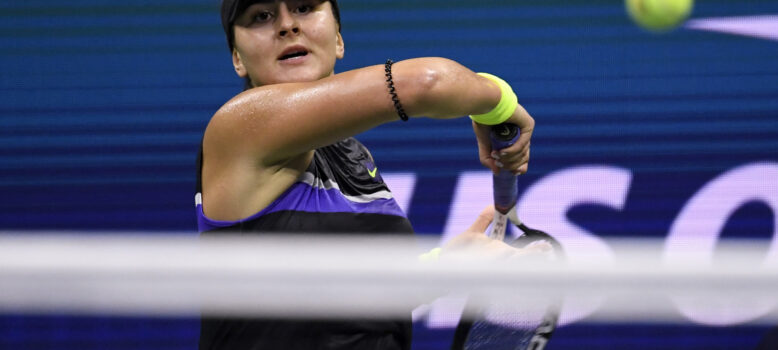

It is endlessly amazing to contemplate what Bianca Andreescu has already become at age 19, earning the distinction of being the first teenager to make the U.S. Open women’s final since Caroline Wozniacki in 2009.
The U.S. Open used to be a haven for teenage sensations. In fact, 20 years ago, when Serena Williams won her first U.S. Open and her first major singles championship, three of the four semifinalists were teenagers. Serena was 17, Venus Williams was 19, and Martina Hingis was 18. Yet, a lot of words seem less impactful than statistics and facts, on the eve of a blockbuster U.S. Open women’s final against Serena Jameka Williams. I will have an Andreescu essay after the women’s final, and then a commentary next week to put her larger identity in perspective.
For now, simply absorb the amazing facts surrounding this force of nature:
Bianca Andreescu was down set point in set 1.
She was down *5-2 and *5-4, 30-0 in set 2.
She beats Belinda Bencic in straight sets to make the #USOPEN final at age 19 in her FIRST main-draw appearance in New York.
Incredible………… eh?#AccentUSO#AccentCanadian
— Tennis Accent (@accent_tennis) September 6, 2019
Bianca Andreescu has not lost a full-length match since March 1 in Acapulco to Sofia Kenin.#AccentUSO #USOPEN
— Tennis Accent (@accent_tennis) September 6, 2019
Bianca Andreescu enters the #USOPEN final having lost only one match at a major this year.#AccentUSO
— Tennis Accent (@accent_tennis) September 6, 2019
Bianca Andreescu has made the final of Indian Wells, Toronto, and the #USOPEN in her first main-draw appearance at each of those 3 events.#AccentUSO
— Tennis Accent (@accent_tennis) September 6, 2019
Because her ranking wasn't high enough, Bianca Andreescu had to play 7 Indian Wells matches, not 6, and 6 Toronto matches, not 5.
1 win away from not only winning Indian Wells, Toronto and the #USOPEN in the same year, but doing so by winning 20 matches, not 18 or 19#AccentUSO
— Tennis Accent (@accent_tennis) September 6, 2019
Bianca Andreescu at Indian Wells, Toronto and the #USOPEN in 2019:
19-0 record heading into Saturday vs. Serena
Seeds defeated: 11
5 in Indian Wells, 3 each in Toronto and New York
Major champions defeated: 4 — Kerber, Muguruza, Serena, Wozniacki #AccentUSO
— Tennis Accent (@accent_tennis) September 6, 2019
WHEN SERENA WILLIAMS COMPETED IN HER FIRST #USOPEN WOMEN'S SINGLES FINAL, BIANCA ANDREESCU HAD NOT BEEN BORN.
YES, THAT DESERVES CAPITAL LETTERS!@MZEMEK #ACCENTUSO https://t.co/Ed276aCZnX
— Tennis Accent (@accent_tennis) September 6, 2019
19yo Bianca Andreescu joins a list of just 6 women to have reached a major final in 4 major appearances or less.
On Saturday she has a chance to tie the fastest record held by Monica Seles in the Open Era, who won 1990 Roland Garros in her 4th major appearance. #USOpen pic.twitter.com/IcXbzg018w
— WTA Insider (@WTA_insider) September 6, 2019
Additional context:
Maria Sharapova won 2004 Wimbledon in her 7th major appearance.
Jelena Ostapenko won 2017 Roland Garros in her 8th major appearance.
— WTA Insider (@WTA_insider) September 6, 2019
🇨🇦 Bianca Andreescu 44-4 match record in 2019, 13 match winning streak, 30 hardcourt wins…running out of things to say…Numbers are just off the charts for a 19-year old playing first full year on tour #USOpen
— John Horn (@SportsHorn) September 6, 2019
A few words about teenagers in women’s tennis are merited, as the tennis world prepares for a showcase match between Bianca and Serena:
The rise of Coco Gauff at age 15 — and the urgent discussion that ascendance has created about the need to manage her schedule and not overexpose her to the main professional tennis circuit — has reminded a lot of women’s tennis observers that the quality of teenage players hasn’t decreased. At the very least, the topic of teenage stars can’t be viewed in a linear fashion because of new rules put in place to limit the activity of younger teenage players on tour.
If you are at least 40 years old, you recall the 1991 U.S. Open women’s semifinals, when two teenagers, Monica Seles and Jennifer Capriati, crushed the tennis ball in a riveting, explosive, high-octane matchup which heralded the future of the sport.
Both players won multiple major champions. Seles, had she not been stabbed, could have become a more successful major champion than Steffi Graf. The Seles-Graf rivalry could have become the 1990s version of Chris Evert versus Martina Navratilova.
A reminder about Evert and Navratilova:
MOST GRAND SLAM FINALS — Women's Singles
Evert, 34
S. Williams, 33
Navratilova, 32
Graf, 31Federer, the Men's leader, has 31.
— José Morgado (@josemorgado) September 6, 2019
Capriati’s case, however, is more instructive. Capriati was only 15 years old on that semifinal day in New York. She had an overbearing tennis parent who did not give her space to grow into a well-rounded human being. Her life was imbalanced and careened into a ditch on multiple occasions.
Capriati is one of a few central reasons why the WTA age rule limits exist. This has made it harder to compare today’s teenagers to those from the 1990s and previous decades (such as Tracy Austin and Evert herself, who both rose to prominence well before turning 20).
Teenagers are rightly protected more by the modern WTA Tour, shielded against the effects of “too much, too soon.” Given that context, Bianca Andreescu’s continued ability to laugh at “too much, too soon,” with this avalanche of wins and wins and more wins, is positively remarkable.
We will see if she can win one more match on Saturday, with the whole world watching, against Serena Williams.
Matt Zemek
Matt Zemek has written about tennis professionally since 2014 for multiple outlets. He is currently the editor of tennisaccent.com and the co-manager of Tennis With An Accent with Saqib Ali. Tennis With An Accent blends Saqib Ali's podcasts with written coverage of professional tennis. The TWAA Podcast hosted Darren Cahill earlier this year. The podcast is distributed by Red Circle and is available on Stitcher, Google Podcasts, and Apple Podcasts. See Matt's pinned tweet on his Twitter page for links to the TWAA Podcast. Matt is based in Phoenix and thinks the Raptors winning the NBA title was awesome. Saqib will be covering Montreal for Tennis With An Accent.









